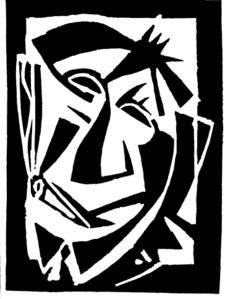 Paul Neuhuys: linocut by Luc Boudens (2000)
Paul Neuhuys: linocut by Luc Boudens (2000)
In fact I am learning Neuhuys with Neuhuys, walking with him, his poems, his publications, his participation in musical demonstrations, in exhibitions which, with Ça Ira! , were extremely lively.
I am also going to stress publications that were parallel to Dada, not because Paul Neuhuys belonged to Dada, not because it is fashionable, (it never will be) but because my own research attracted a certain number of authors who created Dada in 1916 and 1918, as well as Pierre Albert-Birot, who created the review SIC, and Jacques Costine, one of the founders of the review Contimporanul in Bucarest in 1920. In fact all this older generation saw somethingh new in my reviews.
You must also accept the fact that I can speak in my own name, as I hate the hypocritical “we” used in knowledgeable studies of the past, however recent; I am in fact taking it on myself to talk about Paul Neuhuys and Ça Ira!, not because I want to play a part, but rather to make up what has been neglected: this author and his review, because the Belgians were left outside the considerable dynamic movement that took place in the first half of the century – as shown in the reviews Nord-Sud, SIC (sons, idées, couleurs), Contimporanul, Zenith, Ma, the various Dada publications, Maintenant, Het Overzicht (another forgotten Belgian), Littérature, de Stijl, Vorticism, etc, to which I do not hesitate to add Ça Ira!.
Whoever wants to understand the twentieth century must travel through these reviews, not along the official paths of Mauriac, Valéry, Gide, Martin du Gard, the commitments of Malraux or Aragon and so many others who are no more than bystanders, except for Louis-Ferdinand Céline, James Joyce and Kafka, who, in their personal research, were in their time syntheses of an absolutely new world, through a receptivity proper to release a new age and to cleave to it.
As for Paul Neuhuys, his poetic work is closely linked to his need for publication; he is no writer for the writer, he looks around and takes the risk of publishing other poets and essayists, with considerable success.
And now, after a closer view, I have seen what is proper to Paul Neuhuys. I am beginning to see the poet, precious, fragile, light, ironical, held by some kind of need for love (not in the mystical sense, not with a great deal of fuss) real, tangible, solid love inasfar love distrusts words, since it would rather simply be made, just as real poetry, which has no other definition, is made.
I have seen Paul dancing, light and airy, leaping “out of the worlds of fury” to add to this article some of his own words. I met him more than ten years ago; undoubtedly he was there expecting us.
I saw that he was unique, he isn’t boring, he has enjoyed life to the full, he has avoided boredom, even when he was making cigars, his “job”, as they say.
And I know that, whether, grave, serious, light, superb, withdraw, vigilant, curious, attentive, loving, open, generous, passionate, laughing, sad, commited, musician, delighted, young or rich, I know that in all that he is everywhere, in his indefinable presence and that he is striving to be only himself, while he brings into his thirst for life poets as contrasted as Henri Michaux, Blaise Cendrars, Paul Joostens, Floris Jespers, Michel de Ghelderode, Jean Paulhan, E. L. T. Mesens, Clément Pansaers, Marcel Mariën, who are his familiar companions.
The great merit of the Jacques Antoine éditions in Brussels in publishing the twenty numbers of Ça Ira! (1920-1923) is not simply a recognition of something. This publishing house illuminates the first half of the century whose store of wealth is still so badly know. [...]
In any case, going through the twenty numbers of Ça Ira! is no small matter. It was astonishing reading. Whereas many of the reviews of the same period have become (with the exception of Dada) artistic domains even when anti-Art, Ça Ira! today would be called ‘left wing’, as this label is so generally used to condemn anyone who challenges either the Soviet traditionalism – just an example – or the extreme conservatism that hides Watergate from us.
Henri CHOPIN
Collection OU, 7, Ingatestone, Essex, 1977.



